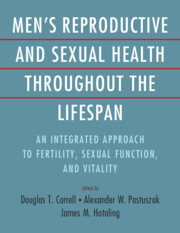 Men's Reproductive and Sexual Health Throughout the Lifespan
Men's Reproductive and Sexual Health Throughout the Lifespan Book contents
- Men’s Reproductive and Sexual Health throughout the Lifespan
- Men’s Reproductive and Sexual Health throughout the Lifespan
- Copyright page
- Contents
- Contributors
- Preface
- Section 1 An Introduction to Men’s Health Care
- Section 2 The Biology of Male Reproduction and Infertility
- Section 3 Clinical Evaluation and Treatment of Male Infertility
- Section 4 Laboratory Evaluation and Treatment of Male Infertility
- Section 5 Medical and Surgical Management of Issues of Male Health
- Chapter 32 Hypogonadism in the Male
- Chapter 33 Selective Androgen Receptor Modulators in the Treatment of Hypogonadism and Men’s Health
- Chapter 34 Male Fertility and Testosterone Therapy
- Chapter 35 Sleep and Men’s Health
- Chapter 36 Molecular Biology and Physiology of Erectile Function and Dysfunction
- Chapter 37 Evaluation of the Male with Erectile Dysfunction
- Chapter 38 Lifestyle Modifications for Erectile Dysfunction
- Chapter 39 Medical and Surgical Management of Erectile Dysfunction
- Chapter 40 Surgical Management of Peyronie’s Disease
- Chapter 41 Medical Management of Benign Prostatic Hyperplasia
- Chapter 42 Evidence-Based Management of Chronic Orchialgia and Chronic Prostatitis/Chronic Pelvic Pain Syndrome
- Index
- References
Chapter 34 - Male Fertility and Testosterone Therapy
from Section 5 - Medical and Surgical Management of Issues of Male Health
Published online by Cambridge University Press: 06 December 2023
- Men’s Reproductive and Sexual Health throughout the Lifespan
- Men’s Reproductive and Sexual Health throughout the Lifespan
- Copyright page
- Contents
- Contributors
- Preface
- Section 1 An Introduction to Men’s Health Care
- Section 2 The Biology of Male Reproduction and Infertility
- Section 3 Clinical Evaluation and Treatment of Male Infertility
- Section 4 Laboratory Evaluation and Treatment of Male Infertility
- Section 5 Medical and Surgical Management of Issues of Male Health
- Chapter 32 Hypogonadism in the Male
- Chapter 33 Selective Androgen Receptor Modulators in the Treatment of Hypogonadism and Men’s Health
- Chapter 34 Male Fertility and Testosterone Therapy
- Chapter 35 Sleep and Men’s Health
- Chapter 36 Molecular Biology and Physiology of Erectile Function and Dysfunction
- Chapter 37 Evaluation of the Male with Erectile Dysfunction
- Chapter 38 Lifestyle Modifications for Erectile Dysfunction
- Chapter 39 Medical and Surgical Management of Erectile Dysfunction
- Chapter 40 Surgical Management of Peyronie’s Disease
- Chapter 41 Medical Management of Benign Prostatic Hyperplasia
- Chapter 42 Evidence-Based Management of Chronic Orchialgia and Chronic Prostatitis/Chronic Pelvic Pain Syndrome
- Index
- References
Summary
Exogenous testosterone functions as a male contraceptive. As a result, men treated with testosterone who desire fertility will need help when trying to restore or preserve fertility. In this chapter, we provide a framework for counseling and managing hypogonadal men who desire fertility. We explore strategies ranging from cessation of exogenous testosterone to using human chorionic gonadotropin, selective estrogen receptor modulators, aromatase inhibitors, or recombinant follicle-stimulating hormone with or without testosterone to preserve Sertoli and Leydig cell function. Furthermore, we provide strategies to maintain fertility while starting testosterone and clinical pathways for a hypogonadal man to recover fertility based on his desired timeline for a pregnancy.
- Type
- Chapter
- Information
- Men's Reproductive and Sexual Health Throughout the LifespanAn Integrated Approach to Fertility, Sexual Function, and Vitality, pp. 269 - 278Publisher: Cambridge University PressPrint publication year: 2023
